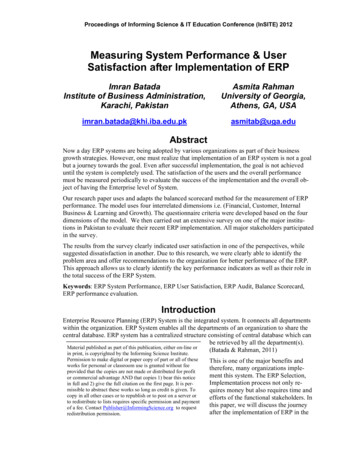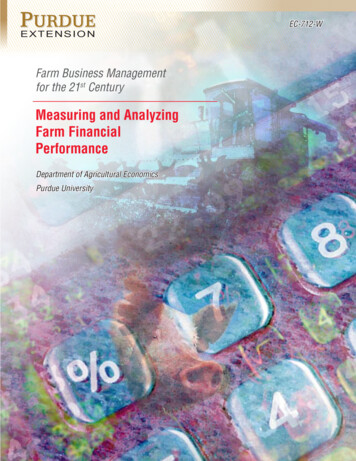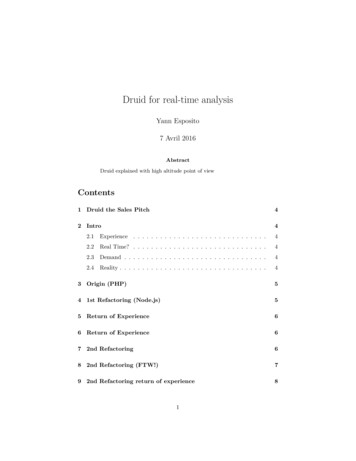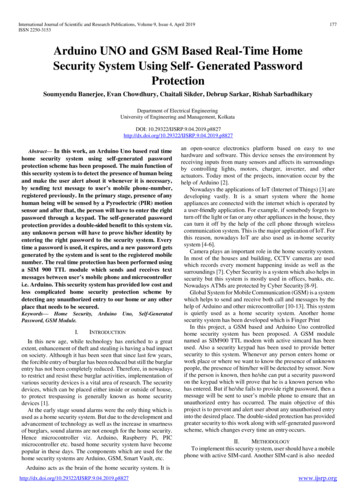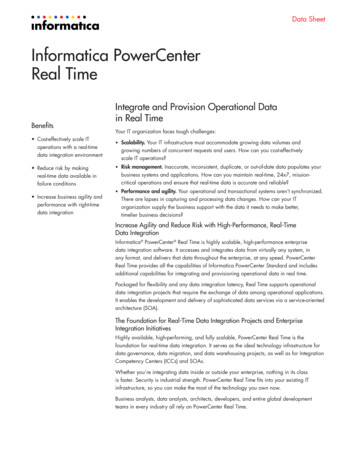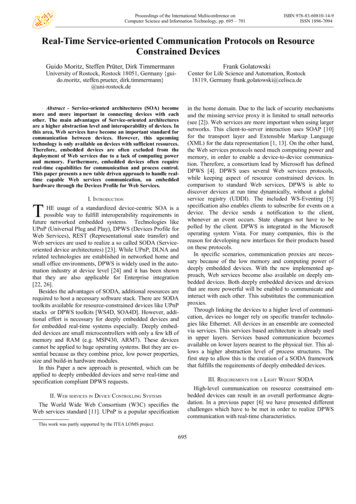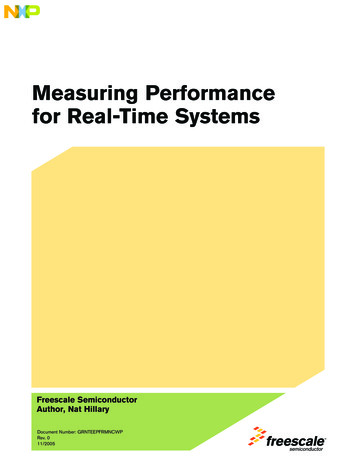
Transcription
Measuring Performancefor Real-Time SystemsFreescale SemiconductorAuthor, Nat HillaryDocument Number: GRNTEEPFRMNCWPRev. 011/2005
CONTENTS1. About This Document .31.1 Introduction.31.2 Scope .31.3 Definitions and Acronyms.31.4 Related Documents.31.5 Author .42. So Exactly What are Real-Time Systems? .42.1 Real-Time, That Means Real Fast, Right? .42.2 So Where Do Real-Time Criteria Come From?.56. Improving the Software Performance of aReal-Time System .106.1 Performance Profiling and AlgorithmImprovements.106.2 Code Butting .107. Issues Affecting Software Performance .107.1 Dynamic Memory Usage.107.1.1 Memory Fragmentation .117.1.2 Memory Leaks .113. The Design of Real-Time Systems .57.1.3 Measuring Memory Usage in Real-TimeApplications .123.1 Characterizing the Real-Time Environment .57.2 Multi-Tasking Designs .123.2 System Design: Assigning Hardware andSoftware Responsibilities .68. Conclusion.134. Building Software Performance into aReal-Time System .75. Measuring Software Performance .75.1 Software Performance Metrics .75.2 Logic Analyzers and In-Circuit Emulators .85.3 Software-Only Performance Profiling .85.4 Source Code Instrumentation and HardwareAssisted Performance Measurements .9
1. About This Document1.1 IntroductionReal-time computer systems are all around us, in large and small applications. The control and monitoring system of anuclear power plant is an example of a real-time system. So is a pacemaker or a real-time first person video game. Whatmakes these systems unique is the fact that time is used to dictate whether they operate correctly, or not.In the examples above, these timings are critical. If the nuclear control and monitoring system does not respond tomeltdown conditions quickly enough, then the impact is catastrophic. If a pacemaker does not respond to changingconditions fast enough, then the impact is catastrophic for the patient. For the gamer, a system that does not respond ina timely manner normally leads to a lost life in the virtual world.Okay, so the gamer losing a virtual life is not so critical. Or is it? If this system does not meet the performance criteria ofthe customer base, then they will choose not to use it. Therefore, the real-time characteristics of the game, which areessential for customer satisfaction, become business critical.So time is an essential part of the definition of a real-time computer system, and software execution performancebecomes all-important. Performance refers to the response time or throughput as seen by the users.But how do you build performance into an application? For that matter, how do you test the performance of anapplication? What about when your application works correctly, but not quickly enough?Real-time systems present unique challenges to the definition, development and testing of software. This is the focus ofthis paper.There are many issues surrounding the manufacture of real-time systems, and this paper aims to identify them and todiscuss possible solutions. The solutions discussed are based primarily on software performance measurementtechniques. For multi-tasking applications, however, there are no metrics that can be used to guarantee performance. Inthis realm, the paper discusses the use of algebraic prediction methods such as Rate Monotonic Analysis andinvestigates how the accuracy of these techniques may be affected by using the metrics obtained using the performancemeasurement techniques discussed.Starting from the perspective of the developer, the principles of Software Performance Engineering and how these maybe employed to build performance into an application are described. For those applications that have already passed thisstage, some of the aspects of software design and implementation that affect performance, such as multi-tasking anddynamic memory usage are then described, and how these may be resolved.Throughout this paper, the hardware assisted analysis methods utilized by the Freescale Semiconductor CodeTEST product are used as an example of how measurements pertaining to software performance may be made.1.2 Scope1.3 Definitions and Acronyms1.4 Related Documents[Dijkstra71] E.W. Dijkstra, Hierarchical Ordering of Sequential Processes, Acta Informatica 1, pp. 115–138, 1971[Douglass98] Bruce Powel Douglass, Real-Time UML: Developing Efficient Objects for Embedded Systems, AddisonWesley, 1998[Grehan98] Rick Grehan, Robert Moote, Ingo Cyliax, Real-Time Programming: A Guide to 32-bit EmbeddedDevelopment, Addison Wesley, 1998[Heath98] Steve Heath, Embedded Systems Design, Newnes, 1998[Hillary98] Nat Hillary, Bridging the Gap between Requirements and Design with Use Cases and Scenarios, Paperpresented at InDOORS 98, Fifth Annual DOORS User Group Meeting, 1998[Kamer93] Cem Kaner, Jack Falk, Hung Quoc Nguyen, Testing Computer Software, International Thomson ComputerPress, 1993[Smith98] Connis U. Smith, Lloyd G. Williams, Software Performance Engineering for Object Oriented Systems: A UseCase Approach, Performance Engineering Services, 1998[XANALYS00] The Memory Management Reference, http://www.xanalys.com/software tools/mm/index.html[SEI01] Software Technology Overview; Rate Monotonic Analysis, /rma.html[Kit95] Edward Kit, Software Testing in the Real World: Improving the Process, Addison-Wesley, 1995Freescale SemiconductorMeasuring Performance for Real-Time Systems, Rev. 03
[Leveson93] Nancy Leveson, Clark S. Turner, An Investigation of the Therac-25 Accidents, IEEE Computer, Vol. 26, No.7, July 1993, pp. 18–41[Myers79] G.J. Myers, The Art of Software Testing, John Wiley, 1979[Wettersten96] Erik Wettersen, Implementing Performance Engineering, Presentation from InterWorks Technical UsersForum of Interex Conference April 21–24, 19961.5 AuthorAny comments about this document should be directed to:Nat HillaryApplied Microsystems Corporation5020 148th AVE. N.E.P.O. Box 97002Redmond, WA 98073-9702Voice: (425) 882-5259Fax: (425) 883-3049e-Mail: nath@amc.com2. So Exactly What Are Real-Time Systems?Simply put, a real-time system is one that fails if its performance criteria are not met. Within this class of system, there aretwo broad categories: hard real-time systems and soft real-time systems. There is a third category, firm real-time systems,whose definition falls between those of hard and soft real-time systems. For the purposes of making this White Paper asclear as possible, this category of system will not be discussed.A hard real-time system is one that must meet its performance objectives every time and all the time. As soon as one ofthese systems does not meet one of its performance criteria, it fails. An example of a hard real-time system is a fly-by-wireflight control system, where if the system does not respond to a pilot’s commands within microseconds, then the systemfails with potentially catastrophic circumstances.A soft real-time system is one that must meet its performance objectives on average only. This means that if every nowand then a performance deadline is missed, the system does not fail. If, however, the system repeatedly misses itsperformance deadlines, then it fails. An example of a soft real-time system is a streaming media player, where if thesystem does not meet its performance objectives in a single instance, then the buffered information ensures that there isno loss of information. Should this loss continue over time, however, the quality of the connection becomes reduced andmay eventually be lost.2.1 Real-Time—That Means Real Fast, Right?Not necessarily. A pacemaker is an example of a real-time system, and it does not need to operate at the speed of light. Itsimply needs to operate fast enough to guarantee the health and safety of the patient. A real-time system, then, is simplyone in which performance criteria are a critical part of its definition, so much so that when these performance criteria arenot being met, the system is considered to have failed.It’s important to note here that systems whose definition include such performance criteria as “shall work twice as fast asits predecessor” or “will handle incoming messages as fast as possible” are NOT real-time systems. The performancecriteria here are too subjective to have any credence as real-time objectives. For real-time systems, a definition wouldmore likely appear as “response time between input from the pilot and full flight control surface movement shall be noless than 16 ms, and shall not exceed 20 ms.” In this definition, the criteria against which real-time performancesuccesses are measured are clearly stated. A system definition containing this type of real-time system performancecriteria will normally also include a clear definition of what type of fault correction is required if these objectives are notbeing met.As an example of a real-time system that does not need to be real fast, consider the pacemaker example from earlier. Inthis example, the pacemaker fails if it does not respond to a change in pulse rate of the patient within sufficient time toguarantee that neither discomfort nor cardiac damage occur. With healthy heart rates in the region of 60-70 beats perminute at rest, this means that the pacemaker does not have to be based on cutting edge silicon to meet its real-timeobjectives. It is, nevertheless, a real-time system, as its performance criteria determine the success (i.e., healthy patient),or failure (i.e., injured patient, possibly resulting in death).4Measuring Performance for Real-Time Systems, Rev. 0Freescale Semiconductor
2.2 So Where Do Real-Time Criteria Come From?Most real-time systems exist in a world where their environment imposes performance criteria on them. These criteria maybe determined by physical or logical constraints. An example of a physical constraint is the response of a flight controlsystem, where the system must pass flight control information from the pilot to the flight controls in a timely manner inorder to control the aircraft in flight. For logical constraint, an example is an industrial robot; that is expected to handlework at a piece rate that enables a manufacturing line to meet its expected production margins.Both of these performance criteria are critical. The performance of the flight control system ensures the safety of theaircraft, while the performance of the industrial robot is critical to meeting the business objectives of the customer forwhom it has been installed.As these two examples demonstrate, the environments in which these systems operate and the rates at which theyinteract are all-important. It is these environmental interactions that determine the real-time criteria of a system.In the case of the industrial robot, the environmental interaction is the number of steps that must be completed on eachwork piece, and the number of work pieces that must be processed per unit time. These provide hard and fastperformance criteria for system designers to work with. For flight control systems, the environmental interactions aremuch more difficult to characterize, as the response of the system determines many things, such as aircraftmaneuverability, or the ergonomic characteristics of the design.3. The Design of Real-Time SystemsFor the most part, the development of real-time systems is a black art; there are no consistently used developmentapproaches throughout the embedded industry. This section looks at the issues that must be considered early in thedevelopment of a real-time system, such as characterizing a system’s real-time environment, and breaking the systemdesign into hardware and software components. At this point, there are also decisions to be made, such as whether touse COTS hardware and/or software products and in choosing hardware products, selecting a CPU that has the rightMIPS capability.This section takes a high level look at the issues surrounding the early stages of real-time systems design, up to the pointwhere the hardware and software responsibilities have been defined and assigned.3.1 Characterizing the Real-Time EnvironmentBefore a real-time system can be built, it is necessary to understand the environment in which it must operate, and howthe system must interact with it. This is an essential step, as this is where the performance criteria for the system areidentified and defined.The first step in characterizing a real-time system is to define the system context. This is simply a map of the world ofinterest to the system. This map includes all of the people or other systems with which the system must interact.Once th
[Dijkstra71] E.W. Dijkstra, Hierarchical Ordering of Sequential Processes, Acta Informatica 1, pp. 115–138, 1971 [Douglass98] Bruce Powel Douglass, Real-Time UML: Developing Efficient Objects for Embedded Systems, Addison Wesley, 1998 [Grehan98] Rick Grehan, Robert Moote, Ingo Cyliax, Real-Time Programming: A Guide to 32-bit Embedded


